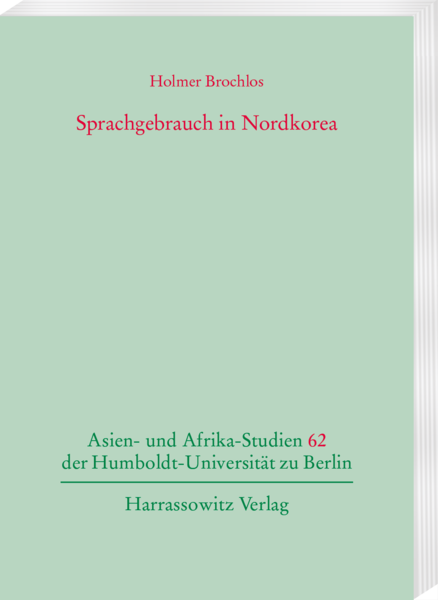Sprachgebrauch in Nordkorea
 Im Zuge der Verbreitung kultureller Inhalte wie K‑Pop und Webtoons hat auch das Interesse an der koreanischen Sprache spürbar zugenommen. Inzwischen existiert eine Fülle von Lehr- und Lernmaterialien, die aber nur auf das Südkoreanische fokussiert sind. Dagegen gibt es – zumindest in europäischen Sprachen – keine komplexe Darstellung des Nordkoreanischen, wo selbst die Namen einiger Buchstaben und die Reihenfolge des Alphabets anders sind als im Südkoreanischen.
Im Zuge der Verbreitung kultureller Inhalte wie K‑Pop und Webtoons hat auch das Interesse an der koreanischen Sprache spürbar zugenommen. Inzwischen existiert eine Fülle von Lehr- und Lernmaterialien, die aber nur auf das Südkoreanische fokussiert sind. Dagegen gibt es – zumindest in europäischen Sprachen – keine komplexe Darstellung des Nordkoreanischen, wo selbst die Namen einiger Buchstaben und die Reihenfolge des Alphabets anders sind als im Südkoreanischen.
Diese Lücke füllt Holmer Brochlos mit seinem Band Sprachgebrauch in Nordkorea, der die Grundlagen des nordkoreanischen Sprachgebrauchs vermittelt. Die Besonderheiten und Unterschiede im Vergleich zur Standardsprache in Südkorea werden mit Fokus auf Rechtschreibung und Lexik darstellt. Da der heutige Stand des „Auseinanderdriftens“ des Sprachgebrauchs nur mit einem Blick auf die historische Entwicklung zu verstehen ist, widmet sich ein Kapitel der Sprachpolitik und Sprachreform in Nordkorea. Ein gesondertes Kapitel behandelt den allgegenwärtigen sprachlichen Führerkult. Es werden zahlreiche Beispiele für den Sprachgebrauch in Nordkorea anhand von Originaltexten aus der Alltags- und Fachsprache gegeben, geordnet nach den Bereichen Politik und Wirtschaft, Wissenschaft und Technik sowie Kultur. Zu jedem Beispieltext gibt es eine Musterübersetzung ins Deutsche, welche sich insbesondere als Lernhilfe für Koreanisch-Studierende eignet. Ein fast 300 Lemmata umfassendes Glossar ausgewählter Nordkorea-spezifischer Termini Koreanisch–Deutsch rundet den Band ab
zum Buch im KatalogPlus
zum Buch auf der Verlags-Website
On Revival: Hebrew Literature Between Life and Death
On Revival is a critique of one of the most important tenets of Zionist thinking: “Hebrew revival,” or the idea that Hebrew—a largely unspoken language before the twentieth century—was revitalized as part of a broader national “revival” which ultimately led to the establishment of the Israeli nation-state. This story of language revival has been commemorated in Israeli popular memory and in Jewish historiography as a triumphant transformation narrative that marks the success of the Zionist revolution. But a closer look at the work of early twentieth-century Hebrew writers reveals different sentiments.
Roni Henig explores the loaded, figurative discourse of revival in the work of Hebrew authors and thinkers working roughly between 1890 and 1920. For these authors, the language once known as “the holy tongue” became a vernacular in the making. Rather than embracing “revival” as a neutral, descriptive term, Henig takes a critical approach, employing close readings of canonical texts to analyze the primary tropes used to articulate this aesthetic and political project of “reviving” Hebrew. She shows that for many writers, the national mission of language revival was entwined with a sense of mourning and loss. These writers perceived—and simultaneously produced—the language as neither dead nor fully alive. Henig argues that it is this figure of the living-dead that lies at the heart of the revival discourse and which is constitutive of Jewish nationalism.
On Revival contributes to current debates in comparative literary studies by addressing the limitations of the national language paradigm and thinking beyond concepts of origin, nativity, and possession in language. Informed by critical literary theory, including feminist and postcolonial critiques, the book challenges Zionism’s monolingual lens and the auto-Orientalism involved in the project of revival, questioning charged ideological concepts such as “native speaker” and “mother tongue.”
zum Buch im KatalogPlus
zum Buch auf der Verlags-Website
